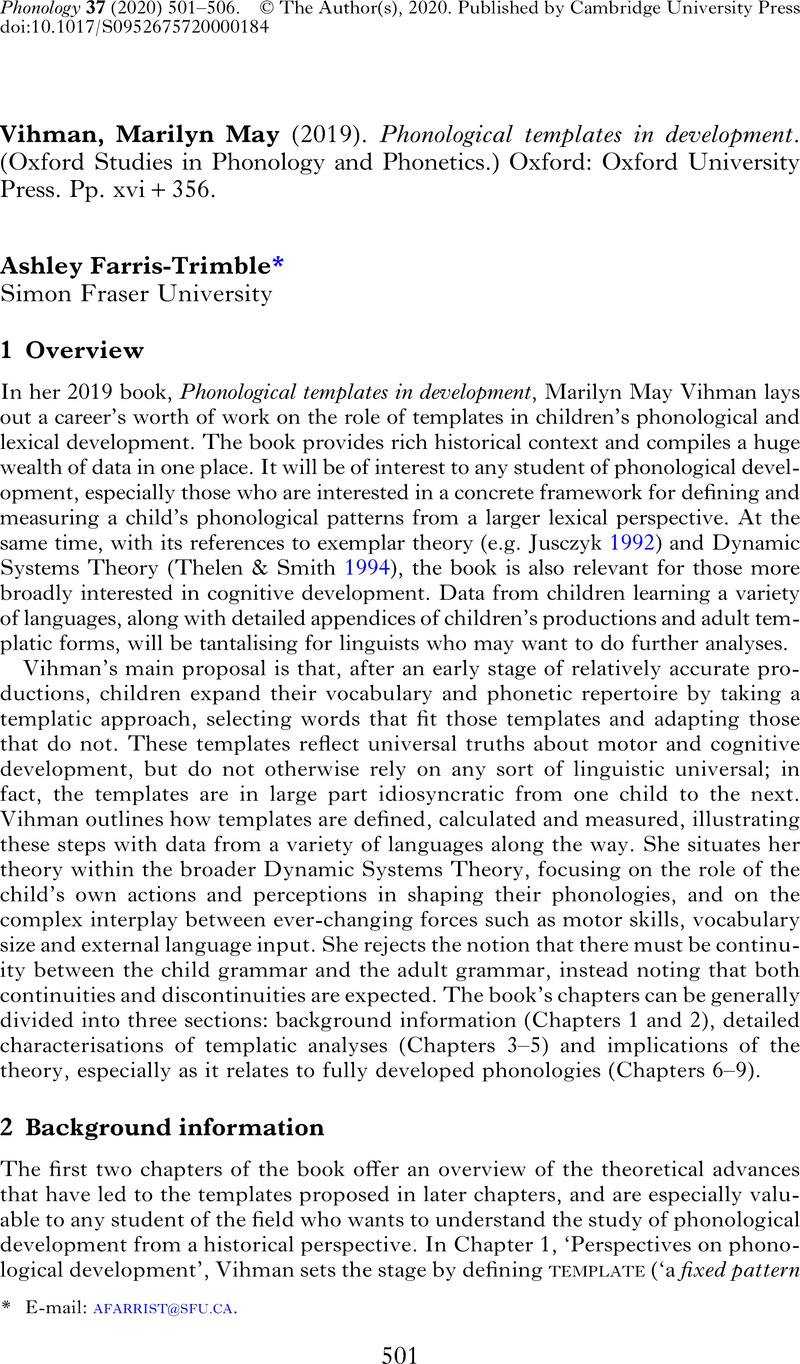No CrossRef data available.
Article contents
Marilyn May Vihman (2019). Phonological templates in development. (Oxford Studies in Phonology and Phonetics.) Oxford: Oxford University Press. Pp. xvi + 356.
Review products
Marilyn May Vihman (2019). Phonological templates in development. (Oxford Studies in Phonology and Phonetics.) Oxford: Oxford University Press. Pp. xvi + 356.
Published online by Cambridge University Press: 10 December 2020
Abstract
An abstract is not available for this content so a preview has been provided. Please use the Get access link above for information on how to access this content.

- Type
- Reviews
- Information
- Copyright
- Copyright © The Author(s), 2020. Published by Cambridge University Press
References
Firth, J. R. (1948). Sounds and prosodies. Transactions of the Philological Society. 127–152.CrossRefGoogle Scholar
Jusczyk, Peter W. (1992). Developing phonological categories from the speech signal. In Ferguson, Charles A., Menn, Lise & Stoel-Gammon, Carol (eds.) Phonological development: models, research, implications. Timonium, Md.: York Press. 17–64.Google Scholar
McAllister Byun, Tara, Inkelas, Sharon & Rose, Yvan (2016). The A-map model: articulatory reliability in child-specific phonology. Lg 92. 141–178.Google Scholar
McAllister Byun, Tara & Tessier, Anne-Michelle (2016). Motor influences on grammar in an emergentist model of phonology. Language and Linguistic Compass 10. 431–452.CrossRefGoogle Scholar
McCarthy, John J. (1982). Prosodic templates, morphemic templates, and morphemic tiers. In van der Hulst, Harry & Smith, Norval (eds.) The structure of phonological representations. Part 1. Dordrecht: Foris. 191–223.Google Scholar
Menn, Lise, Schmidt, Ellen & Nicholas, Brent (2009). Conspiracy and sabotage in the acquisition of phonology: dense data undermine existing theories, provide scaffolding for a new one. Language Sciences 31. 285–304.CrossRefGoogle Scholar
Menn, Lise, Schmidt, Ellen & Nicholas, Brent (2013). Challenges to theories, charges to a model: the Linked-Attractor model of phonological development. In Vihman, Marilyn May & Keren-Portnoy, Tamar (eds.) The emergence of phonology: whole-word approaches and cross-linguistic evidence. Cambridge: Cambridge University Press. 460–502.CrossRefGoogle Scholar
Rvachew, Susan & Bernhardt, Barbara May (2010). Clinical implications of Dynamic Systems Theory for phonological development. American Journal of Speech-Language Pathology 19. 34–50.CrossRefGoogle ScholarPubMed
Samuelson, Larissa K. & Faubel, Christian (2016). Grounding word learning in space and time. In Schöner, Gregor, Spencer, John P. & The DFT Research Group (eds.) Dynamic thinking: a primer on Dynamic Field Theory. Oxford & New York: Oxford University Press. 297–325.Google Scholar
Samuelson, Larissa K., Kucker, Sarah C. & Spencer, John P. (2017). Moving word learning to a novel space: a dynamic systems view of referent selection and retention. Cognitive Science 41. 52–72.CrossRefGoogle ScholarPubMed
Szreder-Ptasinska, Marta (2012). Child phonology as a dynamic system. PhD thesis, University of York.Google Scholar
Thelen, Esther & Smith, Linda B. (1994). A dynamic systems approach to the development of cognition and action. Cambridge, Mass.: MIT Press.Google Scholar
Vihman, Marilyn May & Croft, William (2007). Phonological development: toward a ‘radical’ templatic phonology. Linguistics 45. 683–725.CrossRefGoogle Scholar
Vihman, Marilyn May, Keren-Portnoy, Tamar, Whitaker, Christopher, Bidgood, Amy & McGillion, Michelle (2013). Late talking toddlers: relating early phonological development to later language advance. York Papers in Linguistics (Series 2) 13. 47–68.Google Scholar
Wauquier, Sophie (2014). Templates and representations in phonology: from Semitic to child language. In Bendjaballah, Sabrina, Faust, Noam, Lahrouchi, Mohamed & Lampitelli, Nicola (eds.) The form of structure, the structure of form: essays in honor of Jean Lowenstamm. Amsterdam & Philadelphia: Benjamins. 219–233.Google Scholar





